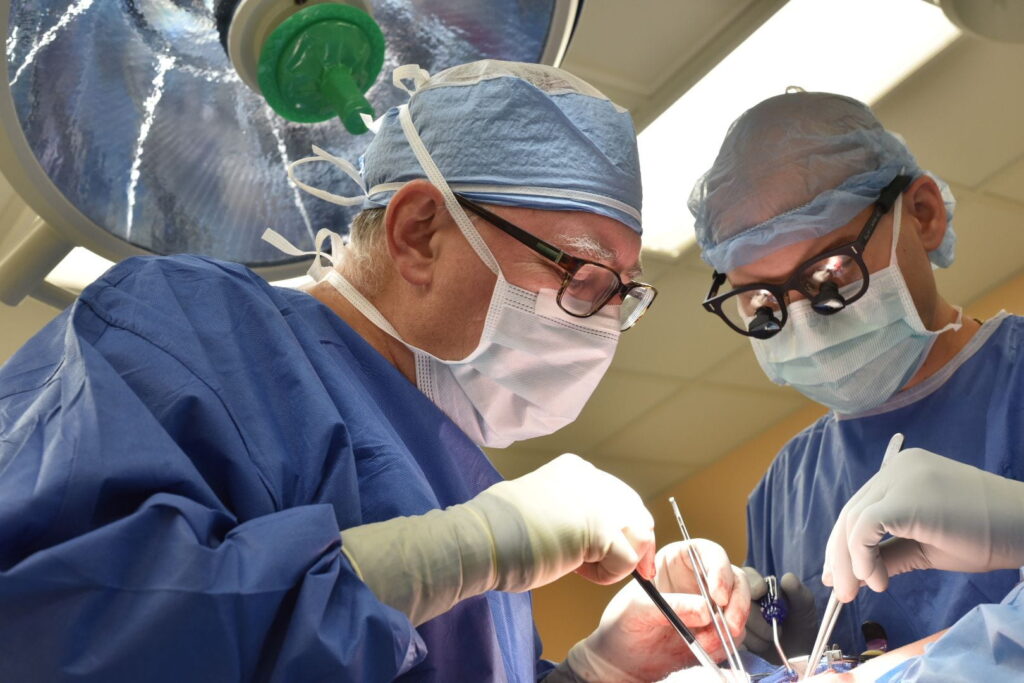Pain, numbness and tingling in the hands or arms can be debilitating. These symptoms can make it difficult or impossible for a person to work or carry out normal daily activities. One cause for these problems is thoracic outlet syndrome (TOS), a group of rare conditions that involve compression of the nerves or blood vessels that pass through the base of the neck and behind the collarbone on the way to the arm and hand.
The most common form of TOS, neurogenic thoracic outlet syndrome (NTOS), involves compression of the brachial plexus nerves. When these nerves that carry movement and sensory signals from the spinal cord to the arms and hands are compressed—usually from congenital variations in anatomy or a history of neck or arm injury—it can cause chronic pain that is difficult to treat. Surgery to relieve the pressure is one treatment for NTOS, but for some people symptoms can come back after surgery. The clinical outcomes of reoperations for recurrent NTOS have never before been defined.
In a recent study, the Washington University Center for Thoracic Outlet Syndrome at Barnes-Jewish Hospital analyzed data from 90 patients who underwent reoperation by Washington University vascular surgeons at the Center for Thoracic Outlet Syndrome for recurrent NTOS after previous operations at other institutions.
The study, published in the journal HAND, opens up the possibility of relieving symptoms and improving function for people with recurrent NTOS.
“This study is the largest and most thorough assessment of patients undergoing reoperations for neurogenic TOS that has been reported in the literature to date,” says the study’s senior author, Professor of Vascular Surgery and Director of the Center for Thoracic Outlet Syndrome Robert Thompson, MD. “The study shows the spectrum of operative findings encountered and the excellent long-term outcomes for these very challenging operations.”
The operations were performed at the Center for Thoracic Outlet Syndrome between 2009 and 2019. Before these anatomically complete supraclavicular reoperations on the upper neck area, patients on average reported substantial disability of the arm, shoulder and hand. During follow-up visits, in some cases over five years after surgery, patients reported an improvement in their symptoms. These long-term outcomes are an important discovery, as recurrence is far less likely more than two years after an operation, according to the Center for Thoracic Outlet Syndrome.
First author Momodou Jammeh, MD, a PGY-3 vascular surgery resident at the School of Medicine, presented these findings at the virtual annual meeting of the American Society for Peripheral Nerve in January.
“Anatomically complete decompression for recurrent NTOS can be safely and effectively accomplished by supraclavicular reoperation, regardless of the type of previous operation,” Jammeh says.
Supraclavicular reoperation, the study reports, can achieve significant symptom reduction and functional improvement for approximately 90% of patients with recurrent NTOS. These findings help vascular surgeons understand this rare disease and the best treatments for patients with recurring symptoms.
Thompson and Jammeh agree that the School of Medicine was uniquely able to complete this landmark study for NTOS because of its expertise and high clinical volume in vascular surgery.
“The case volume for integrated vascular trainees here is unmatched,” says Jammeh. “This comes as no surprise, with vascular surgery faculty who have varied interests including complex aortic disease, cerebrovascular revascularization, limb salvage, iliocaval and pulmonary thrombectomy as well as TOS.”
Vascular surgeons at the School of Medicine are nationally and internationally recognized experts in treating TOS. Last year, Thompson performed the 1,000th operation at Barnes-Jewish Hospital to treat venous TOS. In 2019, surgeons from the Center for Thoracic Outlet Syndrome published important research on false-negative diagnoses of the rare condition.
“These problems are considered relatively rare,” Thompson says. “This study could not have been conducted anywhere but at WashU, given the unusually high volume of TOS patients that we see here, at the world’s leading center for all forms of TOS.”
